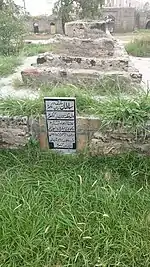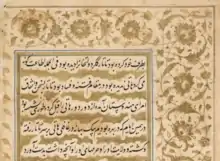Sultan Sarang Khan
Sarang Khan (Persian: سارنگ خان, romanized: Sārang Khān) (d. 1546) was the Second Chief of the Gakhar tribe to hold the title Sultan, who ruled over the region in northern Punjab, in modern-day Pakistan from 1520 – 1546.
| Sarang Khan سلطان سارنگ خان گکھڑ | |||||
|---|---|---|---|---|---|
| Sultan | |||||
 Grave of Sultan Sarang Khan, Rawat Fort | |||||
| 2nd Gakhar Sultan | |||||
| Reign | 1520 - 1546 | ||||
| Coronation | 1520 | ||||
| Predecessor | Hathi Khan | ||||
| Successor | Adam Khan | ||||
| Born | Pharwala Fort | ||||
| Died | 1546 (953 AH) Rawat Fort, Rawat | ||||
| Burial | |||||
| Issue | Kamal Khan Abdal Khan Chuchak Khan Ghazi Khan Aziz Khan Sayyid Khan 16 sons martyred in battle | ||||
| |||||
| Dynasty | Gakhar | ||||
| Father | Tatar Khan | ||||
| Religion | Islam | ||||
Early years
Sarang Khan was born at Pharwala Fort, Punjab to Tatar Khan. During his childhood, aged 9, he was taken along with his brother, Adam Khan, by Tatar Khan to meet the Mughal Emperor Babur and his son, Prince Humayun. In this meeting Babur gifted a fur coat, to the young Sarang and Humayun gifted his sword to Sarang's younger brother, Adam Khan. At this meeting their father, Tatar Khan, was also present, as he had been advised by Daulat Khan Lodi to meet with Babur in order to incite him in attacking India. This meeting took place next to the Indus River, in Attock.
On receiving his gift from Babur, the young Sarang exclaimed, “O King! If, in exchange for this fur coat, I have to give my life for you or your family then I will not hesitate in doing so.” The young Adam said to Humayun upon being gifted his sword, ”O Prince! If I have to destroy the forts of your enemies with this sword then I will not hesitate in doing so.”[1]
Father's assassination

In 1519, Tatar Khan was assassinated by his nephew Hathi Khan, due to envy and hatred, in a late night raid on Pharwala Fort in which he also plundered the city, by doing so he was able to take control. When Babur was made aware of this incident he marched from Khushab and attacked Pharwala.[2]
This incident is recorded in Baburnama by Babur as such:[3]
At the very time when we were in Bahrah, Hati had advanced upon Tatar by a stratagem, had surprised and slain him, and taken his country, his women, and all his property.
War with Hathi Khan
Sarang Khan and Adam Khan, both being young, escaped to Dangali. They then desired their share of the land and thus anarchy and disorder took rise. The hate, enmity, anarchy and discord coming from both sides increased to such an extent that war between Hathi Khan and the two brothers became inevitable and so they began to attack each other.[4]
It is famously known that the vanguards in the army of Hathi Khan declared that they would not strike any with the spear besides Sarang Khan. One of them, named Murad Khan, struck the head and face of Sarang Khan with a spear.[5]
Assassination of Hathi Khan
Hathi Khan made peace with the Kaswals and married a daughter from the family of Basa Khan Kaswal, he also founded a township named after him, called Hathyah. The Kaswals, either due to old enmity or upon the encouragement of Sarang Khan, poisoned Hathi Khan through their daughter. He died due to this poisoning in 927 AH, 1520 CE after 12 years of rule.[6]
Whilst he was in the agonies of death, he sat Sarang Khan by his side and gave him some advice:[7]
1. Do not look in a mirror for the rest of your life, as you received a scar on your face from Murad Khan Badhal. Let it not be that after seeing the scar, malice arises in your heart and that you be suspicious of the Badhals; a Badhal is not disloyal.
2. That woman who poisoned me, she should be given punishment.
3. The Kaswals should be banished as they were not loyal to me and therefore they shall not be loyal to you either.
4. I have many sons and nephews and I do not consider any to be competent and so they should all be given livelihood and not be ruined.
Reign
Sarang Khan paid heed to the advice of Hathi Khan and buried the body of the deceased Sultan in the township of Plakhar, Haveli, Pargana Dangali. After that he heated a Tandoor and placed the woman inside it, burning her and reducing her to ashes. That place thus became known as Tandoorwala. He granted Murad Khan Badhal a robe of honour and gave him the command that the Kaswals be banished. They were stationed in great numbers at Jogyalkot Fort, which is near to the east of Thoa District. After much war and fighting, the fort was destroyed by a land mine and the Kaswals were banished from the land of Pothohar, they chose to settle in Pargana Anderhal.[8]
After the death of Hathi Khan, Sarang Khan assumed leadership and the position of Sultan.
In the mid 16th century, the Afghan king, Sher Shah Suri usurped the Mughal dynasty under Humayun, the second Mughal emperor. Sultan Sarang resisted Sher Shah on the notion of loyalty to the ousted Mughals. Sultan Sarang was later captured by Islam Shah and flayed alive.[9]
Sultan Sarang was thus martyred in 1546 and is buried in a tomb in Rawat Fort. His brother Adam Khan assumed leadership of the tribe and became the next Gakhar Sultan.
Ancestry
| Ancestors of Sultan Sarang Khan | ||||||||||||||||||||||||||||||||||||||||||||||||||||||||||||||||||||||||||||||||||||||||||||||||||||||||||||||||||||||||||||||||||||||||||||||||||||||||||||
|---|---|---|---|---|---|---|---|---|---|---|---|---|---|---|---|---|---|---|---|---|---|---|---|---|---|---|---|---|---|---|---|---|---|---|---|---|---|---|---|---|---|---|---|---|---|---|---|---|---|---|---|---|---|---|---|---|---|---|---|---|---|---|---|---|---|---|---|---|---|---|---|---|---|---|---|---|---|---|---|---|---|---|---|---|---|---|---|---|---|---|---|---|---|---|---|---|---|---|---|---|---|---|---|---|---|---|---|---|---|---|---|---|---|---|---|---|---|---|---|---|---|---|---|---|---|---|---|---|---|---|---|---|---|---|---|---|---|---|---|---|---|---|---|---|---|---|---|---|---|---|---|---|---|---|---|---|
| ||||||||||||||||||||||||||||||||||||||||||||||||||||||||||||||||||||||||||||||||||||||||||||||||||||||||||||||||||||||||||||||||||||||||||||||||||||||||||||
References
- Akhtar, Col. Zahoor. Kai Gohar Nama. p. 74.
- Akhtar, Col. Zahoor. Kai Gohar Nama. p. 75.
- The History of India, as Told by Its Own Historians: The Muhammadan Period by Henry Miers Elliot, John Dowson, Volume IV, p. 235
- Akhtar, Col. Zahoor. Kai Gohar Nama. p. 86.
- Akhtar, Col. Zahoor. Kai Gohar Nama. p. 86.
- Akhtar, Col. Zahoor. Kai Gohar Nama. p. 87.
- Akhtar, Col. Zahoor. Kai Gohar Nama. p. 87.
- Akhtar, Col. Zahoor. Kai Gohar Nama. p. 87.
- The History of India, as Told by Its Own Historians: The Muhammadan Period by Henry Miers Elliot, John Dowson, Volume IV, p. 493
External links
Sultan Sarang Khan | ||
| Regnal titles | ||
|---|---|---|
| Preceded by Hathi Khan |
Gakhar Sultan 1520–1546 |
Succeeded by Adam Khan |